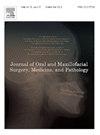脸部的对称——回顾一个复杂的问题
IF 0.4
Q4 DENTISTRY, ORAL SURGERY & MEDICINE
Journal of Oral and Maxillofacial Surgery Medicine and Pathology
Pub Date : 2024-12-18
DOI:10.1016/j.ajoms.2024.11.010
引用次数: 0
摘要
面部对称是感知人脸最重要的特征之一。面部不对称意味着面部两侧不相同。轻微的面部不对称在普通人群中很常见。大多数人的面部都有轻微的不对称,这是人类正常的生理状况。软组织、牙齿和骨骼元素的异常导致面部不对称。不对称有许多致病因素,其病因包括先天性和后天性疾病。对每个分支弓衍生物的胚胎学和解剖学的深入了解对于术后患者的诊断、分级、治疗和随访是必需的。在这篇综述中,我们着重于面部不对称的广泛鉴别诊断。治疗是多学科的,必须与根本原因有关。在制定治疗方案时,全面了解不对称的病因和特征起着至关重要的作用。治疗的时机应基于功能标准、生长、预期结果的稳定性和患者的意愿。出现功能危机的患者应及早治疗。本文章由计算机程序翻译,如有差异,请以英文原文为准。
Symmetry of the face – Review of a complex matter
Facial symmetry is one of the most important characteristics in the perception of a human face. Facial asymmetry means that both facial sides are not identical. Mild facial asymmetry is very common in the general population. Most people have slight facial asymmetry, and this is the normal biological situation in humans. Abnormalities of soft tissue, dental and skeletal elements result in facial asymmetry. Asymmetry has many causative factors and its etiology includes both congenital and acquired disorders. Extended knowledge of the embryology and anatomy of each branchial arch derivative is mandatory for the diagnosis, grading, treatment and followup of postoperative patients. In this review, we focus on the broad differential diagnosis of facial asymmetry. Treatment is multidisciplinary and must be related to the underlying cause. When formulating a treatment plan, complete knowledge of the etiological factors and character of the asymmetry plays a crucial role. The timing of treatment should be based on functional criteria, growth, the expected stability of the result and the patient's wishes. Patients in a functional crisis situation should be treated early.
求助全文
通过发布文献求助,成功后即可免费获取论文全文。
去求助
来源期刊

Journal of Oral and Maxillofacial Surgery Medicine and Pathology
DENTISTRY, ORAL SURGERY & MEDICINE-
CiteScore
0.80
自引率
0.00%
发文量
129
审稿时长
83 days
 求助内容:
求助内容: 应助结果提醒方式:
应助结果提醒方式:


